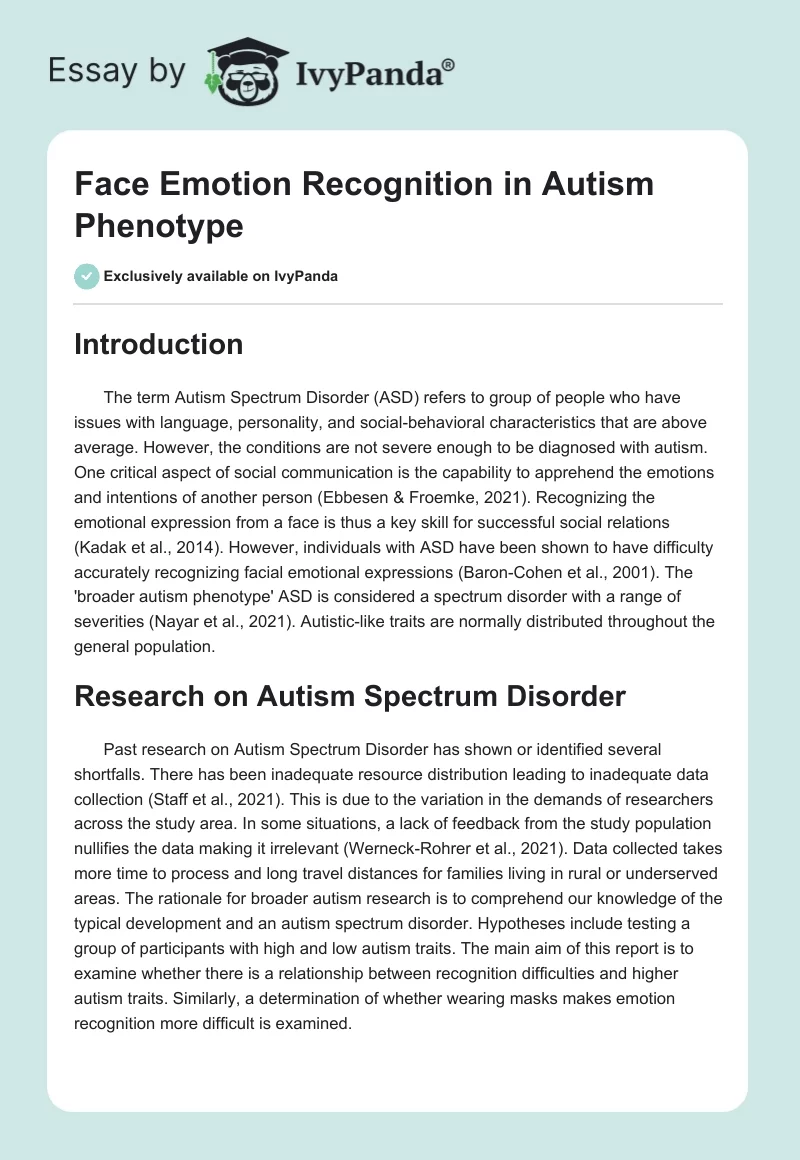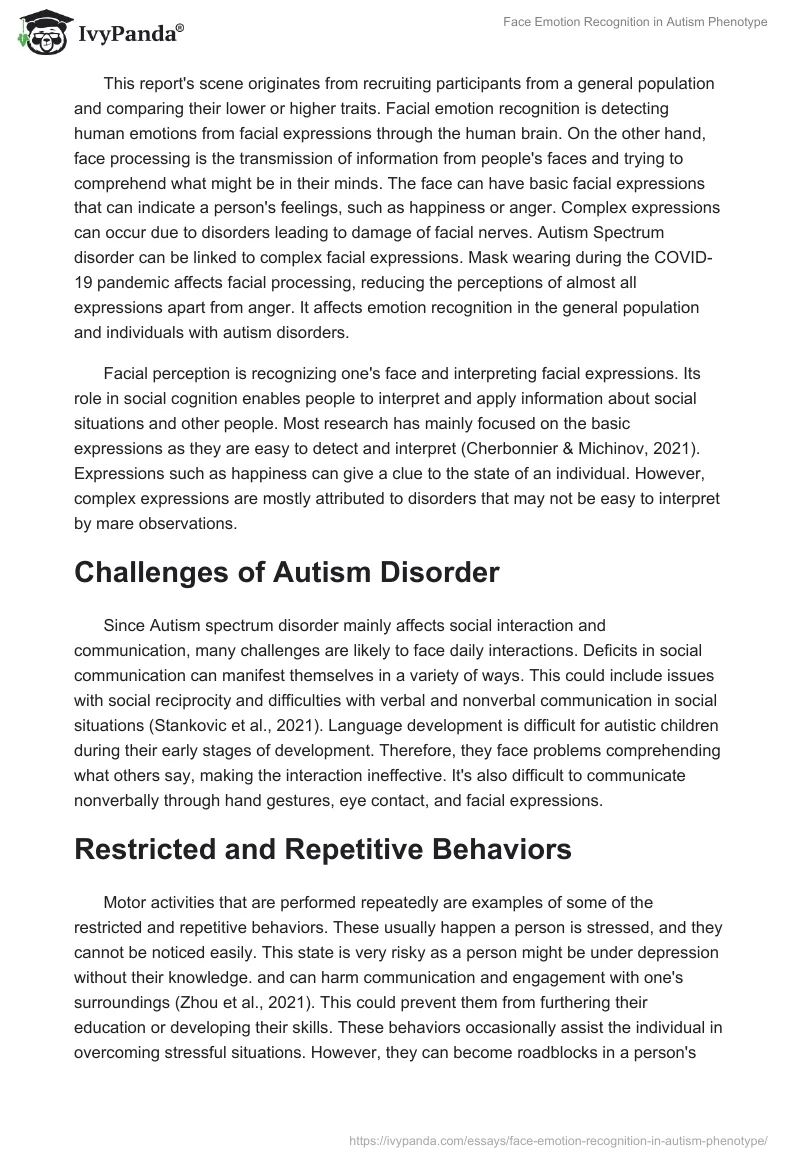Introduction
The term Autism Spectrum Disorder (ASD) refers to group of people who have issues with language, personality, and social-behavioral characteristics that are above average. However, the conditions are not severe enough to be diagnosed with autism. One critical aspect of social communication is the capability to apprehend the emotions and intentions of another person (Ebbesen & Froemke, 2021). Recognizing the emotional expression from a face is thus a key skill for successful social relations (Kadak et al., 2014). However, individuals with ASD have been shown to have difficulty accurately recognizing facial emotional expressions (Baron-Cohen et al., 2001). The ‘broader autism phenotype’ ASD is considered a spectrum disorder with a range of severities (Nayar et al., 2021). Autistic-like traits are normally distributed throughout the general population.
Research on Autism Spectrum Disorder
Past research on Autism Spectrum Disorder has shown or identified several shortfalls. There has been inadequate resource distribution leading to inadequate data collection (Staff et al., 2021). This is due to the variation in the demands of researchers across the study area. In some situations, a lack of feedback from the study population nullifies the data making it irrelevant (Werneck-Rohrer et al., 2021). Data collected takes more time to process and long travel distances for families living in rural or underserved areas. The rationale for broader autism research is to comprehend our knowledge of the typical development and an autism spectrum disorder. Hypotheses include testing a group of participants with high and low autism traits. The main aim of this report is to examine whether there is a relationship between recognition difficulties and higher autism traits. Similarly, a determination of whether wearing masks makes emotion recognition more difficult is examined.
This report’s scene originates from recruiting participants from a general population and comparing their lower or higher traits. Facial emotion recognition is detecting human emotions from facial expressions through the human brain. On the other hand, face processing is the transmission of information from people’s faces and trying to comprehend what might be in their minds. The face can have basic facial expressions that can indicate a person’s feelings, such as happiness or anger. Complex expressions can occur due to disorders leading to damage of facial nerves. Autism Spectrum disorder can be linked to complex facial expressions. Mask wearing during the COVID-19 pandemic affects facial processing, reducing the perceptions of almost all expressions apart from anger. It affects emotion recognition in the general population and individuals with autism disorders.
Facial perception is recognizing one’s face and interpreting facial expressions. Its role in social cognition enables people to interpret and apply information about social situations and other people. Most research has mainly focused on the basic expressions as they are easy to detect and interpret (Cherbonnier & Michinov, 2021). Expressions such as happiness can give a clue to the state of an individual. However, complex expressions are mostly attributed to disorders that may not be easy to interpret by mare observations.
Challenges of Autism Disorder
Since Autism spectrum disorder mainly affects social interaction and communication, many challenges are likely to face daily interactions. Deficits in social communication can manifest themselves in a variety of ways. This could include issues with social reciprocity and difficulties with verbal and nonverbal communication in social situations (Stankovic et al., 2021). Language development is difficult for autistic children during their early stages of development. Therefore, they face problems comprehending what others say, making the interaction ineffective. It’s also difficult to communicate nonverbally through hand gestures, eye contact, and facial expressions.
Restricted and Repetitive Behaviors
Motor activities that are performed repeatedly are examples of some of the restricted and repetitive behaviors. These usually happen a person is stressed, and they cannot be noticed easily. This state is very risky as a person might be under depression without their knowledge. and can harm communication and engagement with one’s surroundings (Zhou et al., 2021). This could prevent them from furthering their education or developing their skills. These behaviors occasionally assist the individual in overcoming stressful situations. However, they can become roadblocks in a person’s daily life. Among the children, they can be manifested in the frequent asking of similar questions.
Emotion recognition difficulties occur due to differences in a race where people have diversified cultures leading to misinterpretation of some gestures. Psychological difficulties and disorders such as anxiety may make facial interpretation difficult. Differences in emotional expression across cultures can make the interpretation of emotions difficult. For instance, people in China and Japan usually express their emotions through unique eye movements. At the same time, individuals from Western cultures use a distinct set of facial and body movements to express each of the seven basic emotions.
Conclusion
In conclusion, Autism Spectrum Disorder makes the interpretation of facial expressions difficult. Human beings can show simple facial expressions depending on their situations. In addition, complex expressions can be linked to some disorders like anxiety. During the Coronavirus pandemic, wearing a mask has made it difficult for facial processing. This is because a different perception can be shown as most expressions are not easily noticed.
References
Baron-Cohen, S., Wheelwright, S., Skinner, R., Martin, J., & Clubley, E. (2001). The autism-spectrum Quotient (AQ): Evidence from asperger syndrome/High-functioning autism, malesand females, scientists and mathematicians. Journal of Autism and Developmental Disorders, 31(1), 5-17. Web.
Cherbonnier, A., & Michinov, N. (2021). The recognition of emotions beyond facial expressions: Comparing emoticons specifically designed to convey basic emotions with other modes of expression. Computers in Human Behavior, 118, 106689. Web.
Ebbesen, C., & Froemke, R. (2021). Body language signals for rodent social communication. Current Opinion in Neurobiology, 68, 91-106. Web.
Kadak, M., Demirel, Ö. Yavuz, M., & Demir, T. (2014). Recognition of emotional facial expressions and broad autism phenotype in parents of children diagnosed with an autistic spectrum disorder. Comprehensive Psychiatry, 55(5), 1146-1151. Web.
Nayar, K., Sealock, J., Maltman, N., Bush, L., Cook, E., Davis, L., & Losh, M. (2021). Elevated polygenic burden for autism spectrum disorder is associated with the broad autism phenotype in mothers of individuals with autism spectrum disorder. Biological Psychiatry, 89(5), 476-485. Web.
Staff, A., Luman, M., van der Oord, S., Bergwerff, C., van den Hoofdakker, B., & Oosterlaan, J. (2021). Facial emotion recognition impairment predicts social and emotional problems in children with (subthreshold) ADHD. European Child & Adolescent Psychiatry. Web.
Stankovic, M., Stojanovic, A., Jelena, S., Stankovic, M., Shih, A., & Stankovic, S. (2021). The Serbian experience of challenges of parenting children with autism spectrum disorders during the COVID-19 pandemic and the state of emergency with the lockdown. European Child & Adolescent Psychiatry. Web.
Werneck-Rohrer, S., Lindorfer, T., Waleew, C., Philipp, J., Prillinger, K., & Konicar, L. (2021). Effects of an intensive slow cortical potentials neuro-feedback training in female and male adolescents with autism spectrum disorder. Wiener Klinische Wochenschrift, 134(S1), 60-68. Web.
Zhou, M., Nasir, M., Farhat, L., Kook, M., Artukoglu, B., & Bloch, M. (2021). Meta-analysis: Pharmacologic Treatment of Restricted and Repetitive Behaviors in Autism Spectrum Disorders. Journal of the American Academy of Child & Adolescent Psychiatry, 60(1), 35-45. Web.


